Overcoming 6 Dark Venue Challenges
September 3, 2014
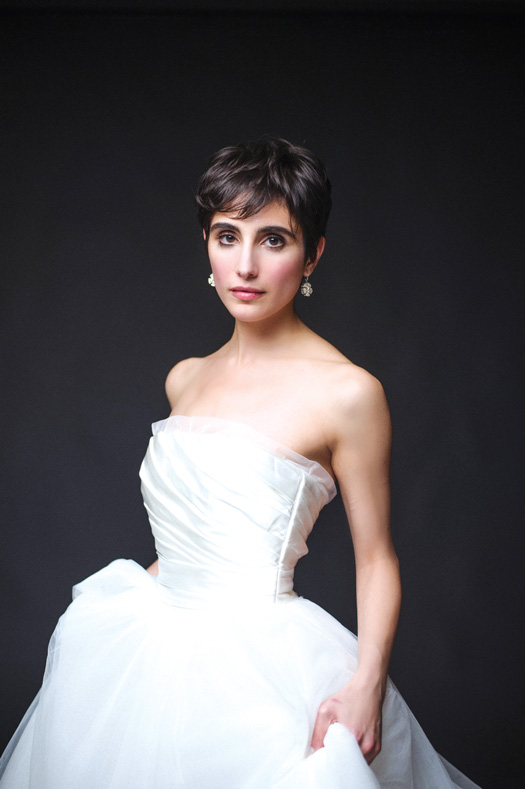
All photos © Justin & Mary Marantz
Challenge #1: The Indoor Portrait
Sometimes shooting outside isn’t an option and you have to find a way to make the portraits work inside. There was a small room at this venue in Connecticut that was used for both cocktail hour and as a dessert room after dinner. We had a short window of time in which the room was empty of both people and tables full of desserts.
We set up a gray backdrop—that took about 10 minutes—then we shot with the couple for 10 minutes (together and alone), and the breakdown was about 5 minutes. If you don’t have or want a backdrop, look for a plain wall to shoot in front of. The venue itself was super dark inside, so all of the light had to come from the gear we had with us.
Setup and Equipment
Normally we bring our smaller one-light setup of a Profoto B1 behind a 42-inch white shoot-through umbrella, but because we knew we had a room to ourselves, we went ahead and broke out the big guns: a 5-foot Profoto Octa softbox coming in from the left and slightly above paired with a D1 Air 500 head (the B1 hadn’t come out yet). We also used a white reflector to fill in the shadows on the right-hand side. Going with the larger light gave us that resulting painterly-looking portrait.
Lens: 50mm | Shutter speed: 1/200 | F-stop: f/2.5 | ISO: 100
Extras
There was some tungsten overhead lighting in the room that we wanted to diminish and used our shutter speed to do so. We then further compensated by raising the power on our D1 with the air remote.
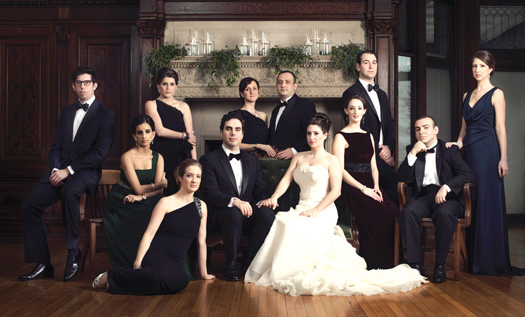
Challenge #2: Indoor Bridal Party Group Shot
This bride had been following our work and specifically requested that we do a Vanity Fair-esque portrait of her bridal party inside this stone mansion (the Branford House in Groton, Connecticut, where we ourselves got married!). She even rented the green settee and had it brought in for this picture.
The dark walls and smaller windows make everything even darker, and on top of that, the wedding took place in the dead of winter when it gets dark early. The other part of this challenge, of course, was getting even, but still interesting (dimensional and dynamic) light across a group this big.
Setup and Equipment
We shot this with the 5-foot Profoto Octa and a D1 behind it, with light coming in from the right side and slightly forward, and a white reflector on a stand on the left side to help kick some light back onto to that far side. (If we were to shoot this same portrait today, we would definitely use the B1, so we don’t have to plug it in, paired with the Profoto XL white 65-inch umbrella.)
Lens: 50mm | Shutter speed: 1/80 | F-stop: f/4.5 | ISO: 250
Extras
We used a slower shutter speed to allow some of the warm ambient light in from the chandelier so that the light felt more found and natural. To make sure we didn’t end up with mixed light, Justin put tungsten gel on the D1. Because we were using the D1 and air remote, we had plenty of power even though this was a larger group and our aperture was stopped down to f/4.5. By bringing the light around more to the front (somewhere around a 45-degree angle) we were able to get a more even spread of light across the group and we also made sure that we weren’t casting shadows from one person’s head onto the next person’s face.
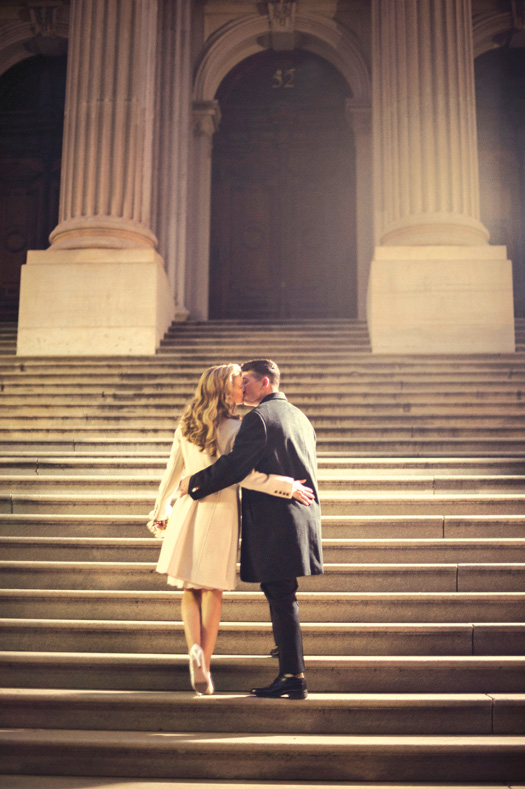
Challenge #3: Outdoor Portrait of Bride and Groom
This couple got married in City Hall Park in Manhattan. They were having a small dinner for family afterward, but it was at a restaurant during normal business hours, so there really wasn’t an interior venue that we could fall back on for portraits inside. Aside from that, it’s New York, and the couple really wanted night shots of the two of them that represented the city; shooting outside was a must.
There was some natural, found ambient lighting in the form of street lamps on the sidewalk, so we mimicked those lights in a way that the viewer could argue that the couple was only lit by a street lamp.
Setup and Equipment
We used the Profoto RFi 1.3×2 softbox on a stand with the SB900 behind it fired by PocketWizards held by Justin as he walked a few steps ahead of the couple just outside of the frame on the right. We liked using the smaller softbox for this setup for a couple of reasons: one, the smaller light source felt more like a street lamp and two, it was more mobile and easier to carry for longer amounts of time up and down the stairs. Also, the softbox is a lot less likely to fall over outside because of wind.
Lens: 50mm 1.4 | Shutter speed: 1/100 | F-stop: f/1.4 | ISO: 1600
Extras
We gelled the flash CTO to match the street lamps and then used a slower shutter speed to allow that ambient light to fill in and make it feel more believable that they were just hanging out in found light versus, “Hey, look what the photographer did.” We liked that the slower shutter speed also gave us some very slight motion blur to feel the movement of them going up the stairs, but if you wanted to avoid that, shooting at 1/125 of a second would probably be more ideal. Because the flash and the street lamps were roughly the same color, we could white balance to taste, but we still decided to keep it pretty warm, as a street lamp would feel.
The flash was pretty close to them (just outside of the frame on the right) and we were working with a pretty high ISO, so we really only needed just a wink of light (1/64 or 1/128 power would probably do). Keeping the flash power low also helped in making the shot feel more natural.
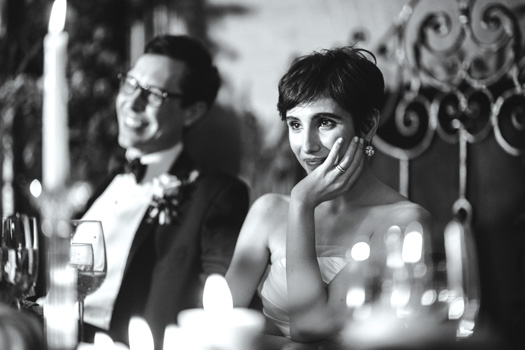
Challenge #4: Low-Lit Toasts
Shooting toasts and other important events at a wedding when the venue is very dark inside can definitely prove challenging. Firing a bounce flash into the room might illuminate the couple so that you get a technically well-exposed image, but it would flood the room with light and create either really boring light or light that looks too “flashy.” Also, there’s the added challenge when the dark venue has dark ceilings (like a barn or industrial space) and bouncing a flash isn’t an option at all. You want to use your light in such a way that you’re not only getting properly exposed images, but making the image richer and more dynamic to draw the viewer in.
The Union League Café, where this image was shot, is a beautiful venue in Connecticut, but it is also a very dark one, right down to its wood walls. The good thing here was the venue’s white ceilings; bouncing a flash would have been an option, but we wanted to go that extra step to create something more artistic.
Setup and Equipment
We went with our basic “one-light setup,” which consists of a light source behind a 42-inch white shoot-through umbrella. In this case, we used the Profoto D1 and fired with the air remote. The one-light setup was coming in from the far left front corner (if you are looking at the couple), and Justin positioned himself by moving his feet so that the light created a 90-degree angle on the couple (where that angle is drawn between light source to subject and subject to photographer). The result is a highly dimensional image full of a pattern of highlights and shadows across the entire frame, making its blacks and whites tonally rich. Because of everything the light is doing at the time the image was taken, the black-and-white conversion is honestly just “desaturate.” The light is what gives it that really iconic 1940s classic feel.
Lens: 85mm 1.4 | Shutter speed: 1/250 | F-stop: f/1.4 | ISO:1600
Extras
By getting our light off-camera, we created direction, highlights and shadows, and therefore dimension. This same setup could be used in the most boring of ballrooms, and using the light alone will make an image feel so much more elegant and high-end. We prefer the umbrella in this case because it gives us a larger—and therefore softer—light, and it also has more fall-off, which is forgiving in case the subject moves (like when they get up to hug the toast-giver).
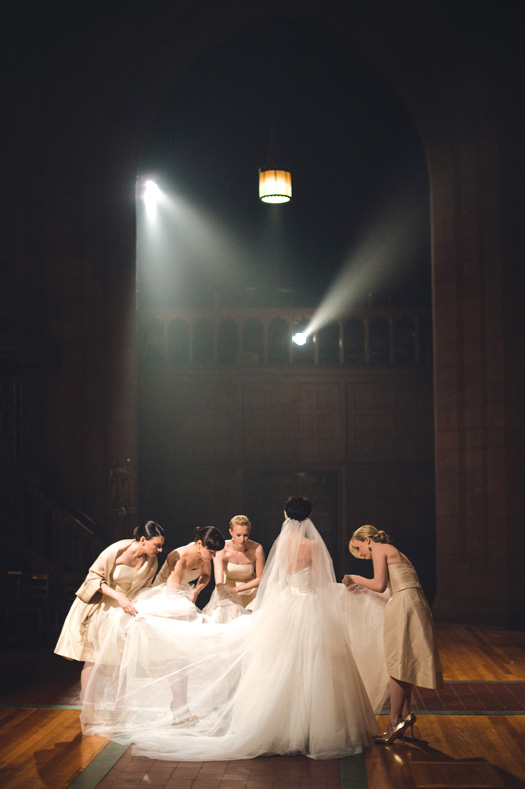
Challenge #5: Inside Churches/Cathedrals
Shooting in a dark cathedral or church (especially those in which flash is prohibited) can be problematic, to say the least. This church in particular was extra strict—not only were we unable to use flash, we weren’t allowed to even move around once the ceremony started.
One big “saving grace” in this church was that it had these amazing pin lights on the altar, allowing us to use those continuous lights and still draw out our angles (moving our feet to complete 90- to 120-degree angles between the light source to the subject and the subject to us) to look for and create directional, dimensional light.
Setup and Equipment
In this case, we just made use of those continuous pin lights, lighting with one just out of the frame that’s coming from the left and above. If we had been allowed to use our flash, we could have set up a “one-light” Profoto B1 behind a 42-inch white shoot-through umbrella just out of the frame on the left and up high on the stand to mimic what the pin light was doing. We would have just needed to remember to gel the B1 to a tungsten color to match the continuous pin lights in the background so we didn’t end up with a mixed-light situation.
Lens: 50mm | Shutter speed: 1/200 | F-stop: f/1.4 | ISO: 1600
Extras
Whether it’s flash or found ambient light, you can still create dimensional, dynamic light just by moving your feet to create those 90- to 120-degree angles.
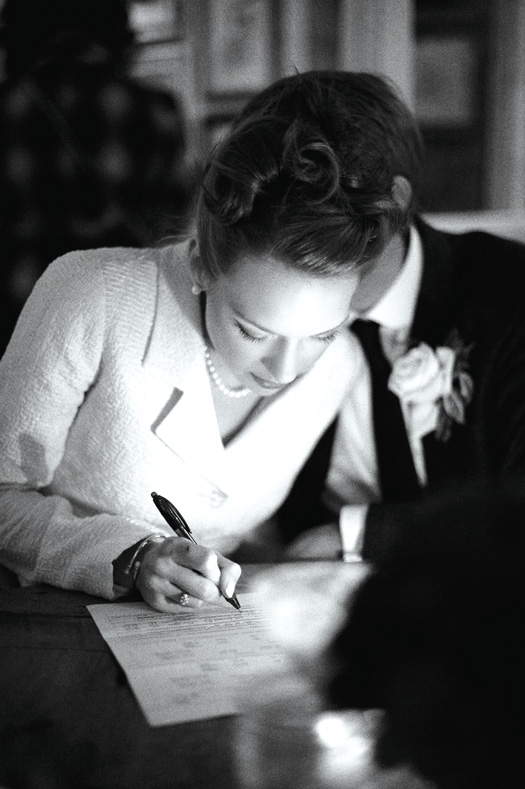
Challenge #6: Candlelit Reception
This was a small, candlelit reception at a restaurant with other people aside from the wedding party, so flash was not permitted. How can you use found, ambient light in a way that still adds dimension and makes for a beautiful image?
This was actually an important moment, as the couple had eloped in New York City (a different couple than the one in scenario #3), and we were their only two guests—and therefore became the witnesses as well! This is a truly candid shot of the bride and groom signing the marriage license at the dinner where it all occurred in a split second; there was no setting them up, and we just had to see what the light was doing, make that calculation on our settings and grab the shot in a matter of a second or two!
Setup and Equipment
In this case, our “equipment” was the tiny tea light candle on the table!
Lens: 85mm | Shutter speed: 1/60 | F-stop: f/1.4 | ISO: 3200
Extras
Maximizing that found ambient light of the tea light candle was key—that’s why we went with a much higher ISO and a slower shutter speed of 1/60 to really let that ambient light burn in on their faces. The higher ISO on the D700 (this shot is from a few years ago and that was the body we were using at the time; we’re both D4s now) added quite a bit of noise, but we think it really works for this shot.
If you were in a scenario where you could use flash, but still wanted it to feel like candlelight, we would do that same basic one-light setup with a 42-inch shoot-through umbrella in the corner. We would have it coming in from the right at about a 90- to 120-degree angle. We would gel the flash to match the candle light (in case we wanted some of the images in color) and we would go with a slow shutter speed (somewhere in the range of 1/60 to 1/125) to let a lot of that candlelight fill in quite a bit. We would keep the flash settings low (1/32 or 1/64 power, depending on how far away the corner was) so that it adds just a wink of light and keeps the flash really subtle.
Lighting wizards Justin & Mary Marantz are a Connecticut-based husband-and-wife team whose wedding work incorporates an editorial influence of 1940s Old Hollywood.
Related Links:
Lighting Your Way Through a Wedding with Justin & Mary and the Profoto B1
Returning to the Golden Age of Hollywood Glam’s Most Iconic Portraits
Making a Typical Wedding Photo Shoot Atypical




